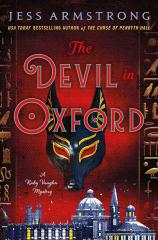The Devil in Oxford: A Ruby Vaughn Mystery
Review
The Devil in Oxford: A Ruby Vaughn Mystery
THE DEVIL IN OXFORD is the third installment in Jess Armstrong’s Ruby Vaughn mystery series. As is suggested by the title, the setting is Oxford, England, in the days before Christmas 1922. While Ruby Vaughn is an American, she spent time in France during WWI and now lives in Exeter with the charming octogenarian Mr. Owen; Mrs. Penrose, their clever and admirable housekeeper; and a black cat. In each novel, Ruby travels to a different location where she stumbles on a murder that she is compelled to solve.
This time, the quartet (including the cat, of course) is staying in Oxford. There is an antiquarian society, and Mr. Owen wants to attend their yearly gathering. Ruby agrees to go with him. A good friend of hers, Leona Abernathy, lives and works in Oxford, so they will be able to reconnect. Leona works for Professor Frederick Reaver, a handsome and well-known anthropologist who is the keeper of the Egyptology collection at the Ashmolean Museum. She is also connected to Julius Harker, who was kicked out of Oxford University and runs Harker's Curiosity Museum. But his body is found during a special exhibition, setting Ruby off into detective mode.
"The engaging first-person narrative, the detailed description of Oxford a century ago, the wonderfully depicted characters, and the clever twists and turns that the plot takes all make for a delightful mystery."
Ruby's romantic interest is a Pellar, or witch, from Cornwall. Ruan Kivell attended school at Oxford and shows up in town just in time to help Ruby with her investigatory endeavors. As in past novels, Ruby is intrepid, intelligent and ingenious, but also incorrect at times. We are introduced to such individuals as Emmanuel Laurent, a professor and aspiring MP whose son befriended Ruan at Oxford; Jack, a young constable who warns Ruby about his superior, whose actions have been suspicious; Lord Amberley, another collector of antiquities; and characters we've met in previous novels, such as Hari Anand, Ruby's good friend and lawyer.
After the murder, Leona's behavior is suspicious. Then she disappears. Ruby's investigation uncovers possible links to drugs, stolen antiquities, a stolen book about magic, a mysterious black dog who might or might not be an apparition signifying death, and Ruby's time in war-torn France. We are as mixed up as if we had been tumbled in the salty waters of the surf off England's coast, which Ruby greatly misses.
Like Ruby, we aren’t sure whom she should trust and who the real killer is. The motivation is not clear, and while we’re aware that the constable is definitely not trustworthy, we don't know who he works for. And, of course, Armstrong continues to develop Ruby's personal life alongside her investigation of Oxford’s darker side.
There are impostors claiming to be Ruby’s mother, who died with her father and sister on the Lusitania. But most importantly, her relationship with Ruan is unsettled. She has tried to ignore her feelings for the witch, but his kindness and his devotion to her, in addition to their special connection, make him irresistible. While it seems unfair that he can read her thoughts, there are times when it’s very useful.
Reading historical fiction is often especially entertaining, or informing, when the past meets the present. For example, Ruby is chided by the local police inspector who tells her that "a woman of your age should have her mind to rearing children. Obeying her husband and tending to her household." Shades of tradwives!
Armstrong lays out the chaos that struck England after the First World War when it comes to poverty and unemployment. "A man survives the war and comes home to what? To simply starve on the streets...when the children of the same men that sent them to war are given every advantage." Which, of course, brings to mind the children of billionaires who will never know a day's hunger or fear of any kind, while those whose birth families are not as endowed must fight for their place in society and deal with the injustices that poverty brings to children.
But while politics plays a minor role in the novel, the driving force is Ruby's determination to figure out who killed Julius, who stabbed Annabelle, Leona's roommate, and who is threatening the safety of those Ruby loves. Will she be able to figure it out? How dangerous will her miscalculations be? For historical fiction buffs, these mysteries are a sure winner. The engaging first-person narrative, the detailed description of Oxford a century ago, the wonderfully depicted characters, and the clever twists and turns that the plot takes all make for a delightful mystery. And the ending is a perfect lead-in for the next Ruby Vaughn entry.
Reviewed by Pamela Kramer on November 8, 2025
The Devil in Oxford: A Ruby Vaughn Mystery
- Publication Date: November 4, 2025
- Genres: Fiction, Gothic, Historical Fiction, Historical Mystery, Mystery
- Hardcover: 336 pages
- Publisher: Minotaur Books
- ISBN-10: 1250374650
- ISBN-13: 9781250374653




